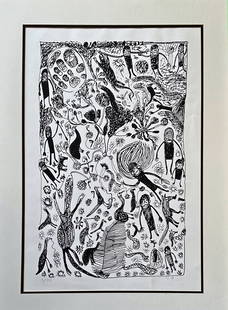
Emu. Australia. 1838.
Similar Sale History
View More Items in Prints & MultiplesRelated Prints & Multiples
More Items in Australian Prints & Multiples
View MoreRecommended Art
View More



Item Details
Description
Print from steel engraving titled „Emus. Oder casuars ohne Haube“.
Artist and engraver unknown.
Notes: Australien oder Neu Holland. 226.
The emu is the largest bird native to Australia and the only extant member of the genus Dromaius. It is the second-largest extant bird in the world by height, after its ratite relative, the ostrich. There are three subspecies of emus in Australia. The emu is common over most of mainland Australia, although it avoids heavily populated areas, dense forest, and arid areas. The soft-feathered, brown, flightless birds reach up to 2 metres (6.6 ft) in height. They have long thin necks and legs. Emus can travel great distances at a fast, economical trot and, if necessary, can sprint at 50 km/h (31 mph). Their long legs allow them to take strides of up to 275 centimetres (9.02 ft) They are opportunistically nomadic and may travel long distances to find food; they feed on a variety of plants and insects, but have been known to go for weeks without food. Emus ingest stones, glass shards and bits of metal to grind food in the digestive system. They drink infrequently, but take in copious fluids when the opportunity arises. Emus will sit in water and are also able to swim. They are curious birds who are known to follow and watch other animals and humans. Emus do not sleep continuously at night but in several short stints sitting down. The Tasmanian emu and King Island emu subspecies that previously inhabited Tasmania and King Island became extinct after the European settlement of Australia in 1788, and the distribution of the mainland subspecies has been influenced by human activities. Once common on the east coast, emus are now uncommon there; by contrast, the development of agriculture and the provision of water for stock in the interior of the continent have increased the range of the emu in arid regions, and it is of Least Concern for conservation. They were a food and fuel source for indigenous Australians and early European settlers. Emus are farmed for their meat, oil, and leather. Emu is a lean meat and while it is often claimed by marketers that the oil has anti-inflammatory and anti-oxidative effects, this has not been scientifically verified in humans. The emu is an important cultural icon of Australia. It appears on the coat of arms, various coins, features prominently in Indigenous Australian mythology, and hundreds of places are named after the bird.
Approx. image size 15, 3 x 9, 3/23 x 14, 1 cm.Condition: medium.
Artist and engraver unknown.
Notes: Australien oder Neu Holland. 226.
The emu is the largest bird native to Australia and the only extant member of the genus Dromaius. It is the second-largest extant bird in the world by height, after its ratite relative, the ostrich. There are three subspecies of emus in Australia. The emu is common over most of mainland Australia, although it avoids heavily populated areas, dense forest, and arid areas. The soft-feathered, brown, flightless birds reach up to 2 metres (6.6 ft) in height. They have long thin necks and legs. Emus can travel great distances at a fast, economical trot and, if necessary, can sprint at 50 km/h (31 mph). Their long legs allow them to take strides of up to 275 centimetres (9.02 ft) They are opportunistically nomadic and may travel long distances to find food; they feed on a variety of plants and insects, but have been known to go for weeks without food. Emus ingest stones, glass shards and bits of metal to grind food in the digestive system. They drink infrequently, but take in copious fluids when the opportunity arises. Emus will sit in water and are also able to swim. They are curious birds who are known to follow and watch other animals and humans. Emus do not sleep continuously at night but in several short stints sitting down. The Tasmanian emu and King Island emu subspecies that previously inhabited Tasmania and King Island became extinct after the European settlement of Australia in 1788, and the distribution of the mainland subspecies has been influenced by human activities. Once common on the east coast, emus are now uncommon there; by contrast, the development of agriculture and the provision of water for stock in the interior of the continent have increased the range of the emu in arid regions, and it is of Least Concern for conservation. They were a food and fuel source for indigenous Australians and early European settlers. Emus are farmed for their meat, oil, and leather. Emu is a lean meat and while it is often claimed by marketers that the oil has anti-inflammatory and anti-oxidative effects, this has not been scientifically verified in humans. The emu is an important cultural icon of Australia. It appears on the coat of arms, various coins, features prominently in Indigenous Australian mythology, and hundreds of places are named after the bird.
Approx. image size 15, 3 x 9, 3/23 x 14, 1 cm.Condition: medium.
Condition
Condition: medium.
Buyer's Premium
- 0%
Emu. Australia. 1838.
Estimate €5 - €7
1 bidder is watching this item.
Shipping & Pickup Options
Item located in Vilnius, ltSee Policy for Shipping
Payment

TOP































































![Emilio Grau-Sala "Sur la Plage" Oil on Canvas: Emilio Grau-Sala (Spanish, 1911-1975), "Sur la Plage" [On The Beach], Oil on Canvas, 1958, signed "Grau Sala" lower right, signed, inscribed "Trouville", dated, and titled to verso. Image: 21.5" H x 2](https://p1.liveauctioneers.com/5649/328023/176731071_1_x.jpg?height=310&quality=70&version=1714409606)













